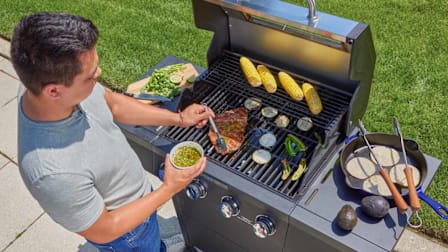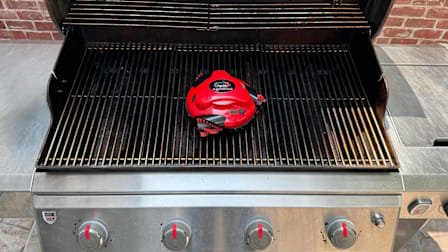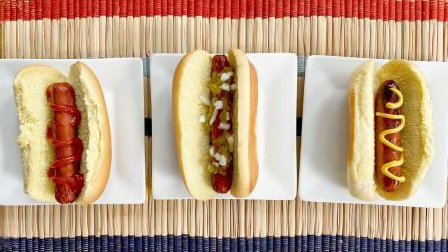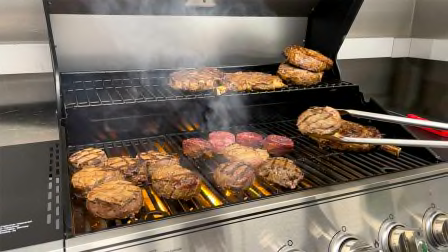How to Cook Thanksgiving Dinner on a Grill
You can whip up the whole feast in under 3 hours without firing up the oven
When you shop through retailer links on our site, we may earn affiliate commissions. 100% of the fees we collect are used to support our nonprofit mission. Learn more.
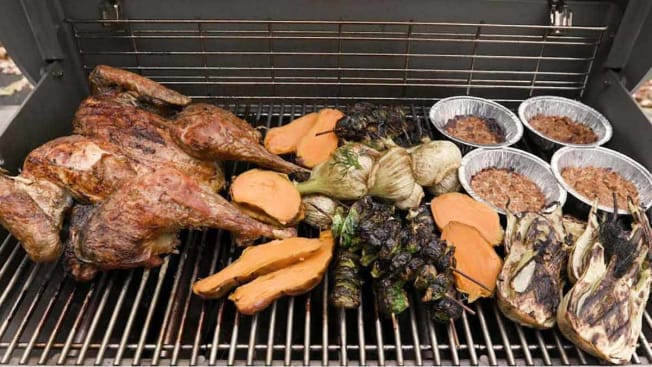
Think of a gas grill as your secret weapon for pulling off the perfect Thanksgiving. Grilling your meal frees up oven space—or eliminates the need for baking altogether—and can even guard against guests congregating in the kitchen.
Unlike an oven, the grill gives you total temperature control. “You can cook directly and indirectly at the same time,” says Larry Ciufo, who oversees gas grill testing at CR. Cooking directly over an open flame produces beautifully charred foods. Over indirect heat, your turkey and side dishes can cook through without burning. “Most ovens can only cook at a single temperature at once.”
At CR’s headquarters in Yonkers, N.Y., we prepared a traditional three-course dinner choosing dishes that help illustrate the techniques you’ll need for your own turkey day. Here, and in the video below, are the menu and methods for cooking Thanksgiving dinner on a grill. Plus, we suggest three great grills big enough to handle the meal.
Start With the Turkey
The turkey, of course, will take longer to cook than the sides or dessert. Plan on roughly 3 hours for a 15-pounder, and work backward.
To prep the bird, start by using a chef’s knife or poultry scissors to cut out the backbone, then slice down along the breast and flatten the bird. Cooking the turkey flat (also known as butterflying or spatchcocking) allows you to start the bird skin side down, which helps the skin get crisp. This method also allows you to cook at a slightly higher temperature because the meat cooks through in less time.
Then Grill the Side Dishes and Dessert
While the turkey is roasting, sanitize your prep area. Then prep your veggies using a fresh knife and clean cutting board. Think of your vegetable sides as falling into two groups: those you want charred and those you don’t. Root vegetables, including potatoes and yams, are best wrapped in foil to protect them from direct contact with the flame. Place them away from the turkey but not over a lit burner.
Veggies like fennel, peppers, or brussels sprouts can—and should—be charred first. Skewer smaller veggies just like kebabs, and cut larger ones like fennel in half to cut down on cooking time. Dress the veggies liberally with oil and seasonings before grilling over direct heat. Once they’re charred, set them on a warming rack or transfer them to a dish if the turkey still has a while to go. You can always toss them back on the grill for a few minutes to reheat before serving.
Plan on 40 to 60 minutes for whole veggies like potatoes or yams and 5 to 10 minutes of direct flame contact for everything else, plus up to 20 minutes of indirect heat for items like fennel to cook through.
For desserts like pies, divide them into small, individual servings and bake them over indirect heat. Using individual foil pans allows you to rotate them to ensure they bake evenly on the grill. Consider buying or prebaking piecrusts in an oven, or go for a crustless apple or pumpkin crumble, which is more forgiving and avoids the problem of overbaked piecrusts.
How to Get the Best Results
Leave yourself enough time. The turkey should take up to 3 hours to cook through. “Make sure an instant-read thermometer hits 165 degrees in the thickest part of the breast,” says James E. Rogers, PhD, CR’s director of food safety research and testing. “And remember that your bird may take even longer to grill if it’s an especially cold Thanksgiving day.”
Grill veggies at 10 and 2. To get beautiful criss-crossed grill marks, think of your grill as a clock and point the top of your veggies toward the 10. Once they develop deep grill marks, rotate the food to point toward the 2. Flip and finish cooking the same way on the second side.
Use oil. It helps prevent food from sticking to the grill grates and promotes that sought-after deep-brown color. Choose an oil with a high smoke point, like canola, peanut, or vegetable. But use it sparingly on food that will be placed directly over the flame to avoid flare-ups.
Avoid cross contamination. Anytime you’re working with raw poultry, you should practice safe food handling. That’s especially true when grilling, because working outside without running water means you can’t quickly wash tools. Use separate cutting boards and utensils for raw turkey and vegetables, or sanitize them in between—and wash your hands, too. Never transfer a cooked turkey back to the platter you used to prep the bird, and make sure to scrub any utensils that touched the raw poultry before you use them to remove the cooked turkey from the grill.
If you grill your turkey with your sides, be extra careful not to let them touch. If your grill is prohibitively small, consider finishing veggies and/or dessert in the oven, where they will reach a safe temperature without cooking alongside unfinished poultry.
3 Great Grills for Cooking a Turkey Dinner
Larger models—usually those with four burners that will hold 28 burger patties—will make grilling a Thanksgiving meal a breeze. A large grill will comfortably hold a 15-pound turkey and a number of side dishes. Choose a model that performed well in our indirect cooking tests, because that’s the crucial function for both the bird and most of the sides. Here are three models that fit the bill:

















